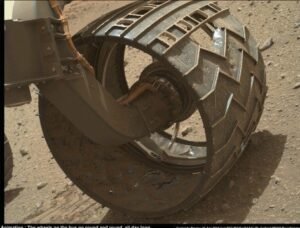NASA’s Indestructible Tires Technology: In recent years, NASA has made significant advancements in tire technology, leading to the development of what is being referred to as indestructible tires. This innovative concept stems from the urgent need for durable, reliable tires that can withstand the extreme conditions of space missions. Traditional tires often face challenges such as punctures, wear and tear, and degradation under harsh environmental conditions. NASA’s efforts to create a tire that can endure these rigors are crucial for successful space exploration and potential applications on Earth.
The motivation behind researching indestructible tires is multifaceted. During space missions, equipment performance is paramount, and tires must operate optimally on various surfaces, from rough lunar landscapes to the rocky terrain of Mars. Failure of tires in such unforgiving conditions would jeopardize the mission and astronauts’ safety. Thus, ensuring that tires can withstand extreme temperatures, high-impact forces, and rough surfaces drives NASA’s innovation in this field.
Beyond the confines of space exploration, the implications of this tire technology extend to everyday driving experiences on Earth. The prospect of indestructible tires could revolutionize the automotive industry, providing enhanced durability and reduced maintenance costs. Consumers may no longer have to contend with frequent flat tires or tread wear, potentially leading to a safer and more economical driving experience. As research progresses, it becomes increasingly clear that NASA’s tire innovations could set a new standard in aerospace and the broader context of tire technology. This fusion of aeronautics and everyday mobility signifies a significant leap forward in understanding and utilizing advanced materials in tire design.
The Technology Behind Indestructibility
NASA’s indestructible tires technology represent a significant advancement in tire technology. They showcase the use of innovative materials and engineering design principles aimed at achieving supreme durability. High-performance composites and intelligent materials are central to the manufacturing of these advanced tires. These materials are engineered to enhance strength-to-weight ratios, enabling them to perform under extreme conditions without compromising structural integrity.
Advanced composites, such as carbon fiber-reinforced polymers, are pivotal in creating these tires. These materials offer exceptional resistance to tensile and compressive stresses, making them ideal for use in environments characterized by rapid temperature fluctuations and mechanical strain. Integrating innovative materials also plays a critical role in the technology; these materials can adapt to varying environmental conditions, significantly contributing to the longevity and resilience of the tires.
The engineering design principles behind the tires are equally important. NASA employs specialized geometries and tread patterns that increase the contact area with the surface, optimizing traction and wear resistance. This is crucial for operations on planetary bodies with uneven terrains, where traditional tire designs could quickly fail. Each design element is meticulously calculated to withstand the extreme stresses associated with space missions.
In addition to advanced materials and engineering, rigorous testing protocols are implemented to measure the performance of these tires under simulated space conditions. These tests involve exposure to extreme temperatures, pressures, and impacts, ensuring the tires maintain their integrity and functionality in the most challenging environments. This comprehensive approach to materials and design reinforces the indestructibility of NASA’s tire technology, ultimately guaranteeing reliability during critical missions.
Real-World Applications and Benefits
The NASA’s Indestructible Tires Technology presents numerous potential applications across various industries beyond space exploration. Primarily, these tires’ enhanced durability and resilience can significantly benefit the commercial transportation sector. With the growing demand for efficient logistics and distribution, incorporating such advanced tires could lead to reduced maintenance costs and increased uptime for commercial vehicles. Businesses could experience substantial savings, as fewer tire replacements equate to lower operational costs and enhanced productivity.
Moreover, the superior performance characteristics of these tires could enhance safety for drivers and passengers alike. For emergency services, including ambulances and fire trucks, employing indestructible tires would ensure these vital vehicles maintain peak performance, even in the most challenging conditions. The ability to withstand punctures, extreme temperatures, and wear would minimize the risk of tire failures during urgent responses, ultimately saving lives and protecting property.
Another noteworthy application lies in off-road vehicles, where these tires could provide substantial advantages. Industries reliant on mining, construction, and agriculture often face extreme conditions that lead to frequent tire damage. Adopting indestructible tires in these areas would enhance operational efficiency while decreasing costs associated with tire replacements and repairs. Furthermore, their robust design could reduce environmental impact by minimizing waste and the carbon footprint associated with tire manufacturing.
In essence, NASA’s indestructible tires’ potential benefits extend well beyond space missions. Their application in various sectors promises to revolutionize transportation on Earth by reducing costs, enhancing safety, and promoting sustainability. Industries can achieve operational excellence and environmental responsibility by integrating this advanced technology into everyday use.
The Future of Tire Technology and Consumer Impact
NASA’s indestructible Tires Technology: Built to Last: The evolution of tire technology stands at a pivotal moment, fueled by groundbreaking innovations derived from NASA’s research into indestructible tires. As these advanced tire concepts transition from theoretical frameworks to tangible products, the implications for consumers and the automotive industry are profound. Indestructible tires promise to enhance vehicles’ safety, longevity, and performance while significantly reducing maintenance costs for drivers.

One of the most immediate impacts of such tire technology will be on consumer choices. As these durable tires become commercially available, drivers will likely prioritize them for their resilience and reduced risk of punctures and blowouts. This shift in consumer preference could reshape market dynamics, driving competitors to invest heavily in similar innovations to meet the demand for enhanced performance and safety features. The rise of indestructible tires may also lead to changes in the automotive design landscape, where manufacturers could implement features optimized for the unique attributes of these tires, thereby enhancing overall vehicle performance.
Furthermore, introducing such durable tire technology will have long-lasting implications for sustainability efforts within the automotive sector. Traditional tires contribute significantly to environmental waste, often requiring replacement and generating substantial landfill material. With the advent of indestructible tires, the lifespan of these products could be greatly extended, decreasing the frequency of replacements and, consequently, the environmental footprint associated with tire production and disposal.
For the average driver, tire technology’s future may translate to not only cost savings but also peace of mind regarding road safety. As we move forward, integrating advanced tire technologies could pave the way for novel driving experiences prioritizing sustainability and superior performance, reinforcing the critical role of innovation in shaping our automotive futures.

